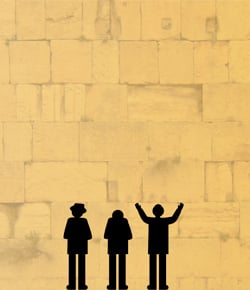For thousands of years, Jews have yearned and prayed for the rebuilding of the Holy Temple, Now, finally, Israel is in Jewish hands again. Why don’t I see the rabbinic leaders in Israel spearheading a building campaign?
Before We Begin
As anyone who has been to Israel knows, the country is nothing short of a modern-day miracle. At the same time, there are very real political and security issues—issues that get even more heated when there is any discussion about the Temple Mount, let alone actually building anything there. That being the case, this entire conversation is purely theoretical, with no relation to the current sociopolitical state of affairs.
Additionally, there is much rabbinic debate surrounding the building of the Third Temple. To keep things short and simple, we’ll just touch on some of the issues that may be involved.
Who Must Build?
When discussing the question of rebuilding the Temple, it is important to keep in mind that, in general, this mitzvah is not an individual obligation, like the mitzvot of tefillin or Shabbat. Rather, it is a communal obligation.1
The obligation to rebuild the Temple may apply only when the majority of the Jewish nation resides in Israel, which currently is not the case.2 In addition, it may apply only when there is a Jewish king or prophet.3
How to Build?
Even if we’re not obligated, should we build the Temple anyway, restoring G‑d’s home one earth?
Truthfully, we don’t even know how to construct it. The dimensions of the Third Temple are somewhat described in the book of Ezekiel, but the interpretation of many verses is subject to debate. In fact, when it came time to build the Second Temple, the Jews built it according to the dimensions of the First Temple, and included only certain aspects that are explicitly stated in Ezekiel.4 It is only the third and final Temple that will be built entirely according to the prophecy of Ezekiel.5
Perhaps the most challenging aspect of all is the placement of the altar, which must be in a very specific location, as the verse states, “This is the altar for the burnt offerings of Israel.”6 According to tradition, the altar is to be placed on the exact spot from which the earth to create Adam was taken and where he later offered sacrifices to G‑d, and where Abraham built the altar to sacrifice Isaac.7 The altar’s location is so essential that when they built the Second Temple, they needed three prophets to vouch for the location they had planned.8 Accordingly, we’d need at least one prophet to help us in our construction project,9 and prophets seem to be in short supply nowadays.
Who Can Go There?
Assuming that somehow we did get the exact dimensions figured out, there is still one big issue: It is forbidden to enter the Temple area in a state of ritual impurity.10 The only way to become ritually pure is with the ashes of a red heifer, which presents its own set of challenges.11
HR Woes
The Temple was (and will be) staffed by kohanim, descendants of Aaron through a direct line of males. In order for a kohen to actually work in the Holy Temple, his genealogy would need to be verified with certainty, a test very few of today’s kohanim would pass.12
Additionally, they would need to wear the priestly garments, made of materials such as threads dyed with the special techeilet (blue) dye, and a selection of precious stones for the high priest’s breastplate—but the specifics of both are a matter of great debate.
So How Is It Going to Happen?
As for how the Temple will ultimately get rebuilt, it is a matter of dispute between the classic commentators.
Maimonides teaches that the Temple will be built by Messiah himself, and in fact its construction will be one of the signs that he is indeed the Messiah.13 One of the Messiah’s first orders of business will be to use his spirit of prophecy to discern who is a priest, as well as the tribal affiliation of each Israelite.14 Additionally, we will have the ashes of the red heifer to purify those who are impure.15
Others are of the opinion that in the messianic era, the Temple will descend ready-built from heaven.16
So Is There Nothing We Can Do?
Despite the above complications, without even lifting a trowel, we can actually fulfill the mitzvah of building G‑d’s home. How so?
Our sages tells us that after G‑d revealed the dimensions of the future Temple to the prophet Ezekiel,17 Ezekiel turned to G‑d and asked, “Why should I tell this to the Jewish people, if they are in exile and will not build the Temple now? Let me wait until they are redeemed, and then I will tell them this prophecy.”
G‑d replied: “Just because My children are in exile, should there be no building of My house?! Learning about the description of My house is as great as the building of it. Go and tell the Jewish people to occupy themselves in learning about the Temple, and in that merit I will consider it as if they engaged in building it.”18
Based on this, the Lubavitcher Rebbe, Rabbi Menachem M. Schneerson, of righteous memory, strongly encouraged learning the laws of the Holy Temple, especially during the period known as the “Three Weeks,” during which we mourn the destruction of the Temple. For through this learning, not only do we fulfill the commandment to build the Holy Temple (even during the exile), but we actually weaken the concept of its destruction—and we ultimately merit its rebuilding with the coming of the messianic era, may it be speedily in our days.
A good place to start is with this tour of the Second Holy Temple in Jerusalem.






Join the Discussion